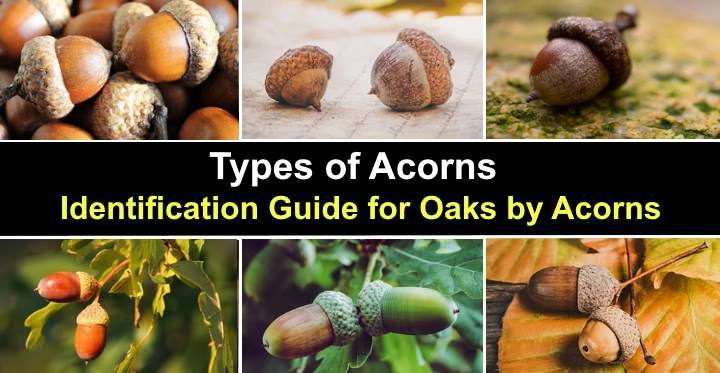An acorn or oaknut is the seed of an oak tree, encased in a thick protective shell. It typically contains one or two oak seeds and is characterized by a scaly or warty cap known as a cupule, which gives it a distinct oval shape. Depending on the species, acorns take between 6 to 24 months to mature.
The features of acorns are commonly used to identify the species of oak tree they belong to. Acorns have a diverse range of shapes and sizes, varying from spherical to oblong and pointed. They also come in different colors such as green, chestnut red, reddish-brown, and black. By observing the color, shape, cupule type, and size of acorns, you can distinguish between different oak species in a given landscape.
What is an Acorn?
The acorn, also known as the oaknut, is the fruit that grows on an oak tree. It consists of one or two large seeds, each protected by a hard shell and enclosed in a cup-shaped cap. Depending on the oak tree species, it can take between six to 24 months for the acorn to mature. Every four years or so, a productive acorn harvest occurs. These fully developed and edible nuts can be collected and consumed.
How to Identify Acorns
Oak trees produce acorns that can be identified by their cup, shape, color, and size. Acorn cups can be scaly, smooth, or hairy, while the acorns themselves are typically spherical or oval-shaped, often with minor ridges. The mature acorns can range in color from brown to red or black. By examining these characteristics, oak tree acorns can be classified according to their species.
1. Identify acorn by its cup scales
To identify the type of acorn, examine the woody cup that resembles a hat. Acorns found in the Americas have overlapping scales covering them. Additionally, examine how much of the nut’s length is enclosed by the cupule. In some acorn cups, up to half of the nut’s length may be covered. You can find acorns with deeper and thinner caps.
2. Identify acorn by its shape
The quality of acorns varies depending on the type of oak they come from. Acorns can typically be categorized into two groups: round and oblong. Upon close inspection, you may notice slender parallel ridges that extend up to the tip. Some acorns have sharp tips, while others have smooth, curved caps.
3. Identify acorn by its color
The color of a mature acorn can be a useful indicator in identifying the species of oak tree it comes from. Oak nuts can mature to colors ranging from light brown, dark brown, reddish-brown, purplish-red, and even black. Green acorns that fall from oak trees before maturing are typically found on the ground.
4. Identify acorn by its size
The size of acorns is a helpful distinguishing factor among various oak tree species. Some acorn nuts can be smaller than 0.5 inches (12 mm) in diameter, while bur oak acorns can reach up to 3 inches (75 mm) in diameter, making them the largest acorns with the biggest kernels. Additionally, the size of the cup may also be a factor to consider. Certain types of acorns have cups that almost completely enclose the nut, while others barely cover the base.
5. Identify acorn by its hairs
Acorns have a unique feature that sets them apart from other nuts, which is the presence of hairs on the cup. These cups are scaly and woody, with the scaly cupules being the most common among oak species. Some types of acorns have a wooly cup with long matted hairs, while others have smooth cups that lack a rough texture.
Are Acorns Edible?
Acorns are a type of edible nuts that can be prepared in various ways such as roasting, crushing into flour, or making a coffee-like drink without caffeine. However, it’s important to note that raw acorns contain toxic tannins that can be harmful to humans if consumed. To make acorns safe and enhance their taste, it’s crucial to leach them before eating.
To leach acorns, soak them in water and drain the water until the tannins are removed. This process should be repeated until the water becomes clear.
The Different Types of Acorns (Sweetest, Largest, Fattiest, Smallest)
It’s critical to identify the sweetest species of nuts if you want to enjoy delicious acorns. From September through early spring, the acorn harvest is collected. In the thick leathery shells, it’s a good idea to look for mature acorns with no holes.
Sweetest acorns: The tannin levels in sweet acorns are the lowest, making them the simplest to cook. Pin oak, burr oak, east coast white oak, and cork oak are examples of oaks with sweet acorns.
Largest acorns: The cupule of big acorns is generally hairy. The east coast white oak, burr oak, and California black oak are the three trees that produce the largest acorns.
Fattiest acorns: Eastern red oak or black oak acorns are ideal for making acorn oil. Among all types of acorns, these nuts have the greatest oil concentration.
Smallest acorns: Little acorns are round and flattened, making them unfit for consumption. The chinquapin and cherry bark oaks produce the tiniest acorns.
White Oak Acorns Vs. Red Oak Acorns
In North America, two types of native oak trees are commonly found: white oaks and red oaks. The distinguishing feature between the two is the shape of their respective acorns. White oak acorns are generally larger and rounder, while red oak acorns are smaller and flatter in shape.
Types of Acorns (With Pictures) – Identification Guide
Let’s take a closer look at how to recognize the sort of common acorns that may be found in woodlands, parks, and deciduous forests.
White Oak Acorn (Quercus alba)
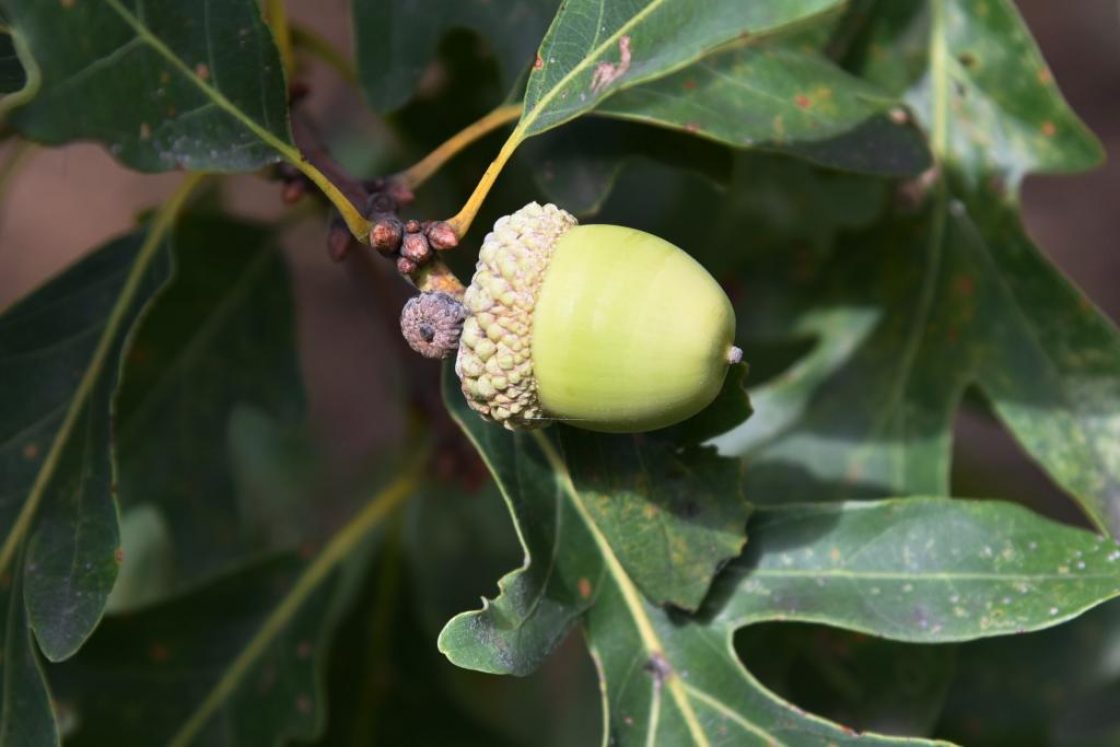
The acorns produced by White Oak trees (Quercus alba) are glossy, light brown nuts with an oblong or ovoid shape. These acorns have a pointed tip and a rounded end, and are typically covered by a scaly woody cup-shaped cap that covers approximately one-fourth of the nut. It takes only one season for the white oak acorns to mature.
To identify white oak trees, one can look for the familiar acorn as described above. The leaves of the white oak have prominent finger-like circular lobes, making them easy to recognize. During autumn, the leaves turn a rich crimson color and can grow up to 9 inches (23 cm) in length. White oaks can grow up to 80 to 100 feet (24 to 30 meters) in height.
Northern Red Oak Acorn (Quercus rubra)
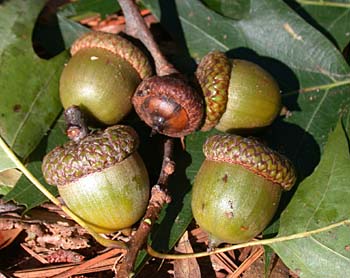
The acorns of Northern Red Oak trees (Quercus rubra) are robust, barrel-shaped brown nuts that are typically 0.75″ to 1″ (20 to 25 mm) in length. The brown nut is characterized by a uniform, wide cupule that covers about one-quarter of its surface area. Northern red oak acorns, like those of other red oak species, take two years to mature on the tree.
To identify the Northern Red Oak tree, one can look for its brown, stumpy acorns and its lobed leaves with pointed tips. In addition, the bark of the tree has shiny stripes, deep furrows, and scaly ridges.
Southern Red Oak Acorn (Quercus falcata)

Acorns from the southern red oak are tiny, domed nuts with a light tan or orange-brown color. The hard nut is covered with a flat, woody covering that covers about one-third of the nut. Acorns grow to be 0.35 to 0.6 inches (9 to 16 mm) long when they are small.
Oak tree identification: The ovate leaves with irregular lobes and bristle tips distinguish the southern red oak tree. Pear-shaped leaves with three rounded lobes adorn the tree as well.
English Oak Acorn (Quercus robur)
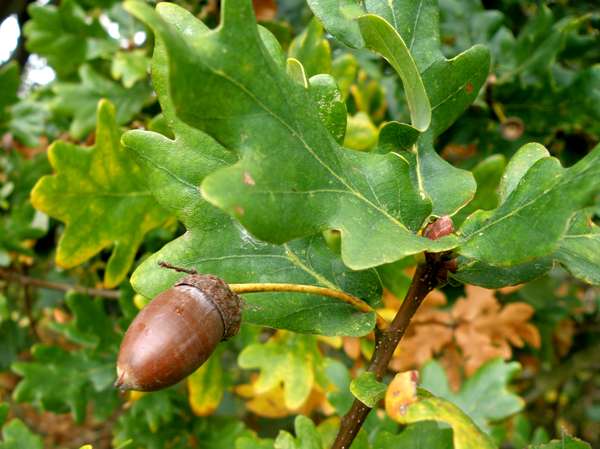
The acorns produced by English oak trees are shiny, brown, and egg-shaped, growing up to 1″ (25 mm) in length. The acorns are covered by cup-shaped caps that have a rough, warty appearance, and they drop out when the cupules mature in the fall. English oak acorns grow in clusters of one to four nuts.
To identify the English oak tree, one can look for its oval, brown acorns that sit in thin, tan caps. The tree’s leaves are obovate and have three to seven pairs of blunt lobes along the margins.
Southern Live Oak Acorn (Quercus virginiana)

Southern Live Oak trees (Quercus virginiana) produce small, ovoid acorns that develop into a distinctive black color. The acorns have rounded black nuts with pointed tips, covered by tan-colored warty caps that cover roughly one-third of the fruit. Southern Live Oak acorns grow in clusters of up to five egg-shaped acorns that measure 0.75″ – 1″ (20 – 25 mm).
To identify the Southern Live Oak tree, one can look for its black acorns and glossy green oblong leaves, which lack the typical lobes of an oak tree.
Scarlet Oak Acorn (Quercus coccinea)

Scarlet Oak trees produce tiny, light brown acorns that are typically found in the fall. The acorns have a sturdy appearance due to their rounded tip and are enclosed in a thick, woody cup that covers up to half of their length. The woody cupules are thick and leathery, giving the acorns a distinct appearance. Scarlet Oak acorns are 0.5 to 1 inch (13 to 25 mm) long.
To identify the Scarlet Oak tree, one can look for its little brown acorns and ovate leaves with thin, finger-like pointed lobes. During autumn, the Scarlet Oak turns a magnificent deep red color, making it easier to spot.
Black Oak Acorn (Quercus velutina)
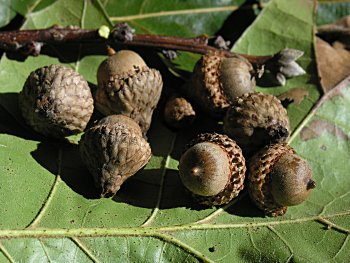
The acorns produced by Black Oak trees are broadly spherical in shape and have a light brown or tan color. The cup of the black oak acorn is unique, with tight scales that form a fringe. The cup is fat and covers half of the nut, measuring 0.5″ to 1″ (13 to 25 mm) in length.
To identify the Black Oak tree, one can look for its light-colored acorns that are shiny and green, with rounded, bristle-tipped lobes that distinguish it from other oak trees. During fall, the tree’s leathery green leaves turn yellow or brownish-red, making it easier to spot.
Chinkapin Oak Acorn (Quercus muehlenbergii)
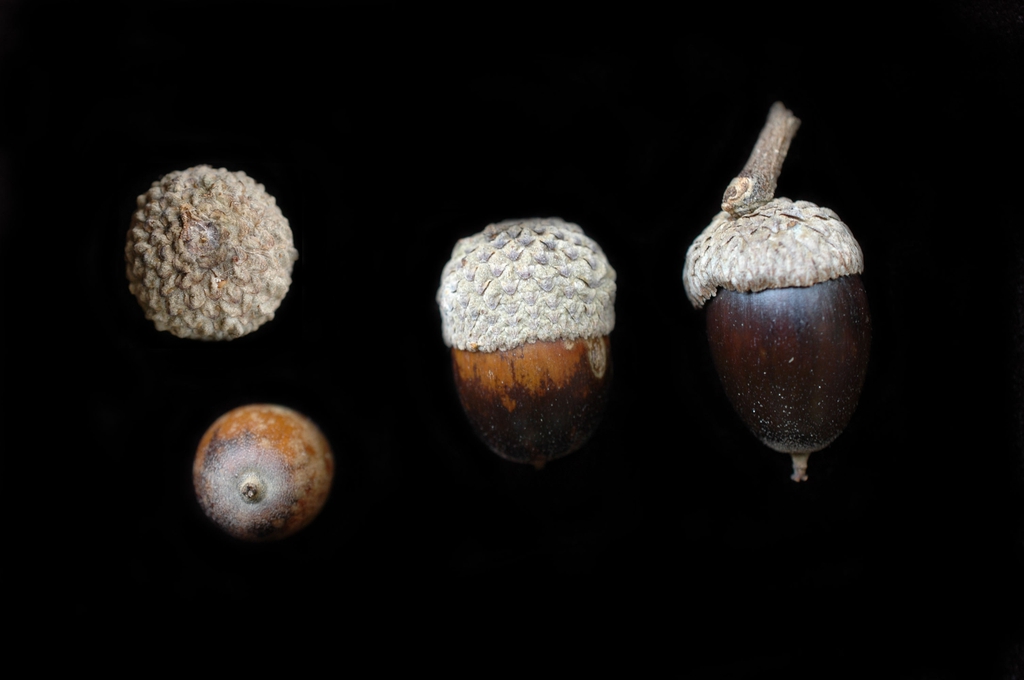
The Chinkapin Oak (Quercus muehlenbergii) produces small acorns that turn dark brown or black when they are mature. The acorns are ovoid in shape and are found in a light gray cupule. The heavenly white meat of Chinkapin acorns is delectably sweet, making them one of the most desirable types of acorns available. The acorns are 0.75 inches (20 mm) long and are sometimes referred to as Chinquapin acorns.
To identify the Chinkapin Oak tree, one can look for its oblong leaves with serrated edges and tiny black acorns. The Chinkapin Oak is a native deciduous tree.
Willow Oak Acorn (Quercus phellos)
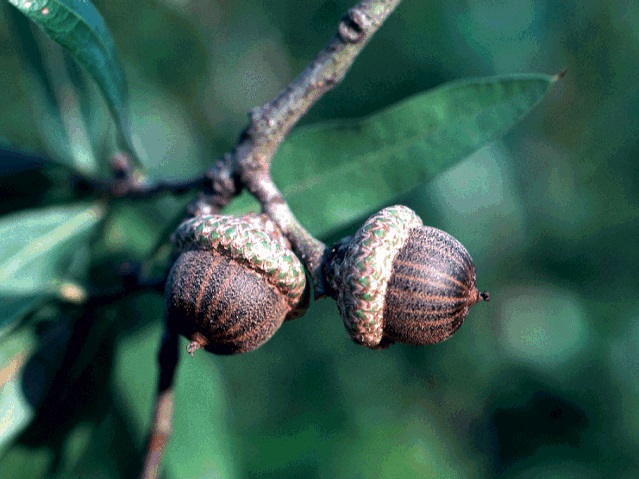
Willow Oak trees produce tiny, nearly black acorns that are spherical in shape. The thick leathery shell of the acorns has visible upright ridges, and they are covered by a scaly, tan-colored covering. The acorns from Willow Oak trees are around 0.5 inch (13 mm) in length and width. These trees are known to produce a lot of acorns.
To identify the Willow Oak tree, one can look for its little black acorns and distinctive leaves. The leaves of the Willow Oak are small and pointed, which sets them apart from other oak tree species.
Shumard Oak Acorn (Quercus shumardii)
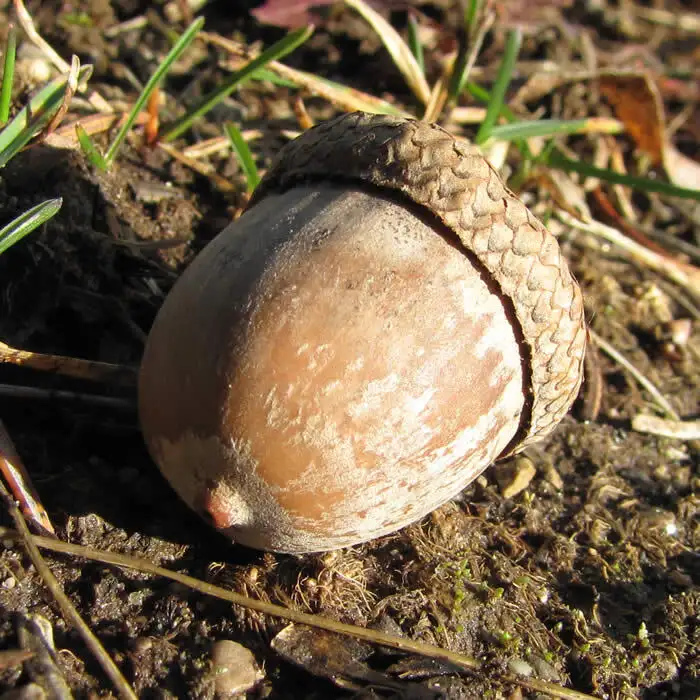
Shumard Oak trees produce egg-shaped acorns with a scaly cap, which are typically 1.25″ (32 mm) long and 1″ (25 mm) wide. The acorns have dark brown stems and grow on short stalks, and are covered with a cap that covers one-third of the nut. The oblong brown acorns are a favorite among wildlife.
To identify the Shumard Oak tree, one can look for its 5-11 lobed leaves with bristled tips and its brown acorns. The tree’s glossy green leaves resemble holly leaves, with the curve between lobes varying greatly across trees, ranging from shallow to nearly halfway through the lobe.
Pin Oak Acorn (Quercus palustris)

Pin Oak trees produce black acorns with a generally flat top, which come in a variety of shapes and sizes. The tiny dark acorns are found on a thin, tan, scaly cap that covers one-third of the nut, ranging in size from 0.5 to 1 inch (13 to 25 mm). Pin Oak trees may produce single or clustered pairs or three-acorn.
To identify the Pin Oak tree, one can look for its distinctive black acorns that have a spherical form. The leaves of the Pin Oak tree have five to seven pointed lobes that are unevenly shaped. Another identifying feature of the tree is the faint orange-brown downy hair tuft on the underside of its leaves.
Bur Oak Acorn (Quercus macrocarpa)
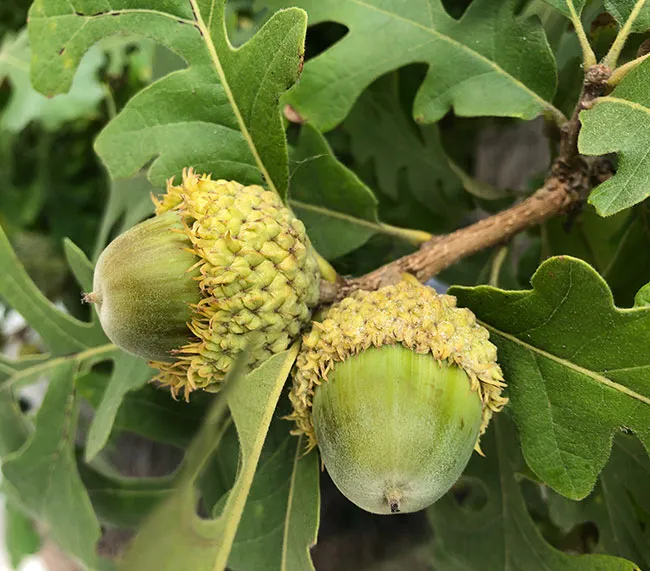
The Bur Oak tree, also known as Quercus macrocarpa, produces the largest acorns of any oak tree. Bur Oak acorns are globose and grayish-brown, with huge, hairy cups that nearly cover the entire nut. These acorns can be up to 1.5 inches (38 mm) long and wide.
To identify the Bur Oak tree, one can look for its grayish-brown acorns with fringed cups. The tree also has large, leathery leaves with five to nine round-tipped lobes, with the lower lobes typically smaller than the upper ones.
California Black Oak Acorn (Quercus kelloggii)

The California Black Oak tree produces egg-shaped acorns that taper to a pointed tip. The acorns have light brown scaly caps and fringes that stretch halfway up the thick nuts when they reach maturity, turning a rich mahogany brown color. The California Black Oak acorns are 1.2 inches (30 millimeters) long and 0.7 inches (18 millimeters) wide.
To identify the California Black Oak tree, one can look for its dark brown egg-shaped acorns and glossy green leaves with seven to eleven deep, bristle-tipped lobes. The leaves of the tree are 3.1-6 inches (80-150 mm) long, with the broadest part in the center.
Coast Live Oak Acorn (Quercus agrifolia)

Coast Live Oak trees produce dark brown, conical-shaped acorns with a broad, orangey-brown, smooth cup at the base, known as Quercus agrifolia. The acorns are reddish-brown in color and can be up to 1.4 inches (35 mm) long and 0.6 inches (15 mm) wide. The cup covers one-quarter of the fruit, and Coast Live Oak acorns develop in eight months, which is less than the typical eighteen months for other types of red oaks.
To identify the Coast Live Oak tree, one can look for its conical-shaped acorns and oval-shaped leaves with spiny-toothed margins.
Post Oak Acorns (Quercus stellata)
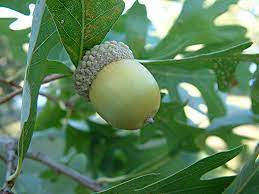
Post Oak immature acorns, known as Quercus stellata, are brown, egg-shaped nuts that grow singly or in pairs on oak trees. The caps of Post Oak acorns are light gray to brown, covering one-third of the reddish-brown acorns that range from 0.5 to 1 inch (13 to 25 mm).
To identify the Post Oak tree, one can look for its brown acorns with tan caps. The leaves of the Post Oak tree have a distinctive shape with three large terminal lobes, and can grow up to 8 inches (240 mm) in length.
Blue Oak Acorn (Quercus douglasii)
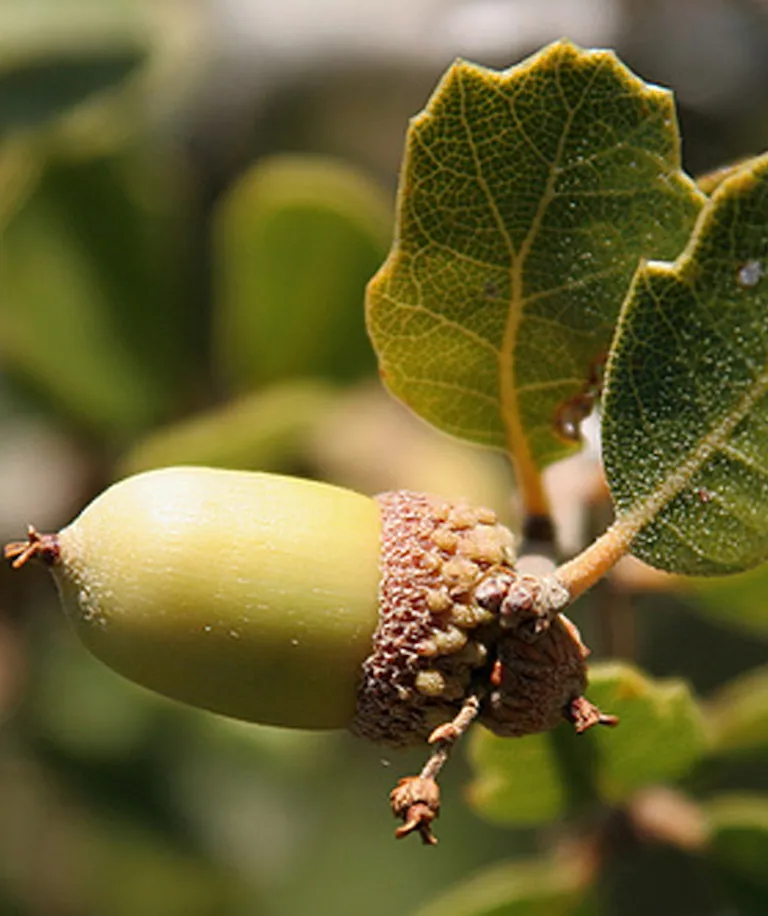
The Blue Oak tree produces egg-shaped acorns that have a pointed apex which narrows as it approaches the tip. These conical acorns mature from green to dark brown, almost black. The cupule of the Blue Oak acorns is 0.2 inches (15 mm) in diameter, and the sweet brown acorns grow from 0.8 to 1.2 inches (20-30 mm) in length.
To identify the Blue Oak tree, one can look for its large pointed acorns placed in thin scaly cups. The foliage of the tree has shallow lobes with rounded endings, and can grow up to 4 inches (100 cm) in length.
How to Harvest Acorns
The ideal time to harvest acorns is in the autumn, just after they have fallen from the oak tree. It is recommended to select larger nuts with smaller caps as they have less tannins. After harvesting the acorns, it is best to dry them indoors to prevent molding. If there are any acorns with tiny holes, it indicates weevil activity, and they should not be used. Additionally, any acorns with green seeds should be discarded.
How to Process Acorns
To consume acorns, it is essential to leach the tannins out of the processed acorns. Rinse the raw acorns in cold water until the water runs clear to remove the tannins from the acorns. The leaching process might take many days depending on how long it takes for all the tannins to leach out of the acorn meat. After that, remove the shells to make shelling acorns easier.
Drying the acorns out can make it easier to find the shell. Once the shells are removed, it is important to remove the black skins on the acorn seeds, which contain bitter tannins. To avoid the acorns from oxidizing, soak them in cold water. Acorn flour can be made from the processed acorns. Roasting acorns in the oven at 350°F (180°C) for 60 minutes is another way to enjoy them, but it is recommended to leach the acorns to get rid of the tannins.
